After the international break, the FAWSL had given fans a spectacle between two top tier teams in women’s football. Both Chelsea Women and Arsenal Women are behemoths of women’s football and have assembled squads full of international stars. Coming into this game both teams were unbeaten, with this game deciding who would continue to gain momentum. With the next league game on 27th October, this match was an opportunity to stake their claim and continue to challenge Manchester City Women for the title.
Before this match, neither side had faced defeat yet. Chelsea won two and drew one in the league, and got off to a good start in the Continental Tyres Cup. Arsenal also enjoyed a perfect start to the season, with three wins in the FAWSL, one in the Continental Tyres Cup and a comfortable victory over Fiorentina in the Champions League. This is Arsenal’s first real test against quality opposition with last season’s fixture resulting in a 5-0 win for the Gunners. Sitting first in the league, Chelsea were only two points behind their rivals before kickoff and a win would propel them to second, two points off Manchester City Women.
This tactical analysis will look to elaborate and detail the tactics employed by both managers at Kingsmeadow and how they tried to claim all three points.
Lineups & squads
Chelsea Women came into this game unchanged. Emma Hayes decided to keep faith in the same eleven that thrashed Bristol City 4-0. The Blues lined up in a 4-4-2 with Bethany England partnering Fran Kirby upfront. Two-goal hero, Guro Reiten retained her place on the wing. Hayes has wanted to settle on the 4-2-3-1 for years but sticks with the two-striker system as it’s the seems to bring out the best of Kirby and England. Ji-So Yun and Sophie Ingle continued their partnership in central midfield together.
Joe Montemurro made three changes to the side that beat Brighton & Hove Albion. Pauline Peyraud Magnin, Jordan Nobbs, and Viktoria Schnaderbeck were replaced by Manuela Zinsberger, Lia Wälti, and Jill Roord. Arsenal looked to play a 4-2-3-1 formation with Roord playing behind Vivianne Miedema.
Chelsea (4-4-2): Berger; Mjelde, Bright, Eriksson, Andersson; Cuthbert, Ingle; Ji, Reiten, Kirby; England.
Arsenal (4-2-3-1): Zinsberger; Evans, Williamson, Beattie, McCabe; Wälti, Little, Roord, Van de Donk; Miedema, Mead.
Arsenal fails to win the midfield battle
A major part of Arsenal’s loss was down to their inability to control midfield and transition possession towards their attackers effectively. Danielle van de Donk, Miedema, and Beth Mead were starved of service but Dutch striker Miedema was especially poor. Kim Little was unable to affect the game as she usually does, and cutting her supply was important for Chelsea. The Blues looked to frustrate Arsenal’s attacking trio by closely marking them and using Bright’s strength in aggressively pushing out to dispossess Miedema early.
Arsenal didn’t lose quality overnight. They were still incredibly dangerous and that was evident from their early goal. Chelsea looked bright but Arsenal just took advantage of space available to them. While Chelsea pressed early, Arsenal were still able to string together passes. Little’s smart run dragged Ingle away from Danielle van de Donk’s run who was stationed between the two centre-backs. The Dutch midfielder scored but that was the only real positive moment for the Gunners.
After the first 15 minutes, Chelsea grew into the game and started to take a hold of proceedings. Arsenal’s two central midfielders were caught napping on multiple occasions and were not able to match the speed of Chelsea’s duo. Ji and Ingle complemented each other perfectly for much of the game. Both players dominated possession and effectively pinned Little, Roord, and Walti. Little, an attacking player by nature was often seen patrolling her defensive third due to the intelligent movement of Chelsea’s attacking players.
While the South Korean midfielder pulled the creative strings with her purposeful running and link-up play, it was Ingle who shored up Chelsea’s midfield by keeping things simple. Regularly recycling possession and offering support wherever it was needed, the Welsh international was always seen within touching distance of her midfield partner and offered a passing outlet any time Ji was unable to progress the ball forward.
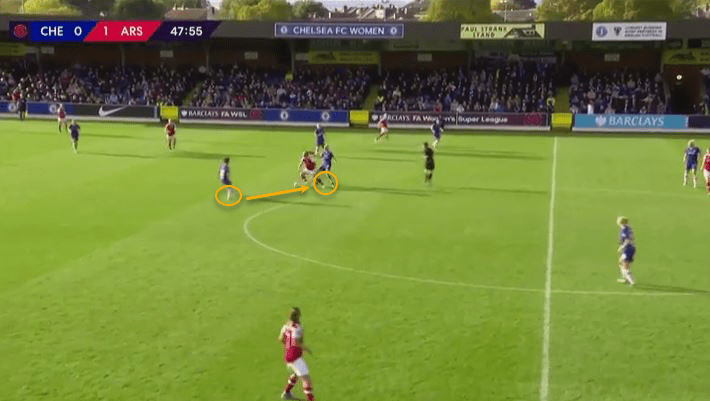
When Arsenal Women were able to bypass Chelsea and shift possession into the final third towards Evans or Van de Donk, they were marshalled well by the opposing full-backs. Both Mjelde and Andersson were exceptional in an attacking and defensive capacity and kept Mead and Van de Donk quiet.
Mjelde is a versatile midfielder who was deployed at right-back and paid close attention to the Dutch attacker. Van de Donk looks to station herself between the lines of midfield in order to commit defenders towards her position, opening up gaps in behind for her to drive into and play her teammates through. Mjelde did well to thwart her efforts and force her to play back or force her down the line.
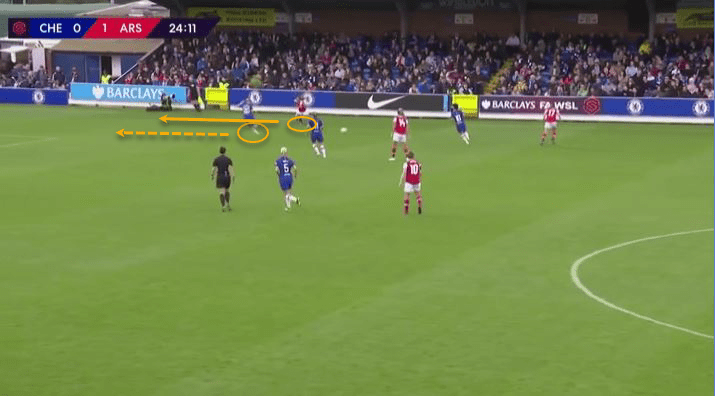
Chelsea Women’s out of possession
Chelsea Women started the match on the front foot by applying early pressure on Arsenal’s defence and midfield. Hayes wanted her team to pressurise Arsenal into giving away possession in different areas of the pitch and force them to make mistakes. Chelsea were energetic and clinical in their passing and movement throughout the match, especially in the opening exchanges. They employed a high press that started with the front two of Kirby and England. Chelsea’s strategy was to disrupt any flow and rhythm between the back four and force their defensive midfielders to drop back slightly.
Out of possession, Chelsea held a narrow 4-4-2 shape with the midfield four holding a slightly narrower shape. The two wingers in Reiten and Cuthbert drifted in to stop Arsenal from playing centrally and getting the likes of Kim Little and Jill Roord on the ball. Though Reiten was more expansive on Chelsea’s left, both wingers were tasked with defensive duties. Arsenal reverted back to a back four and wanted to utilise the pace provided by the two full-backs – Lisa Evans and Kaite McCabe. However, both Reiten and Cuthbert were disciplined in their pursuit of keeping Arsenal’s wider players quiet.
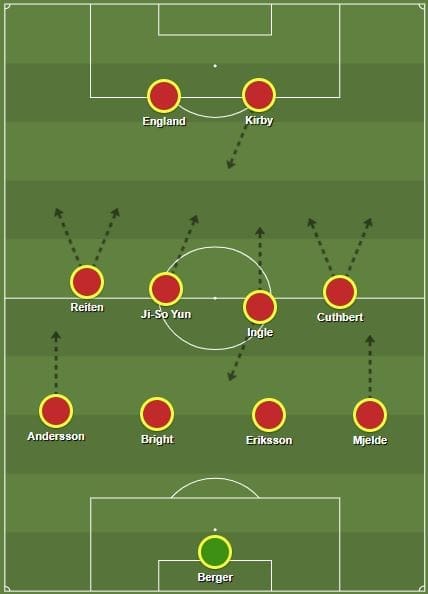
The double-pivot of Ji and Ingle provided further support in pressing Arsenal’s midfield when possession moved into the middle third. Both players shifted towards their side of the pitch to assist the wingers and create a two versus one situation at all times. Hayes would have been pleased to see her tactics executed successfully by her team as it stopped Arsenal from settling into the match early on.
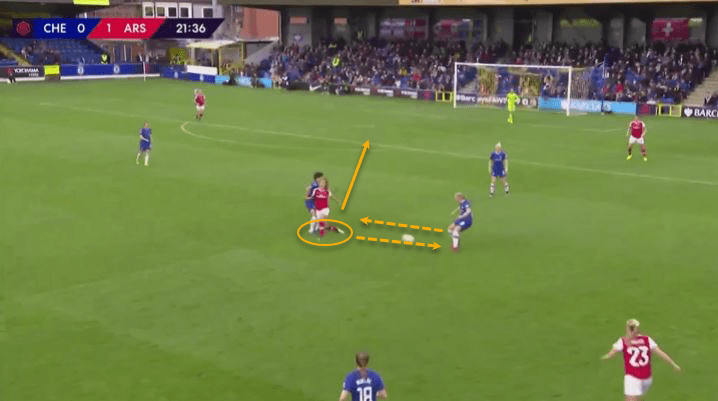
The example shown above exemplified Ji’s contribution in midfield. As Walti receives possession from her centre-back, that triggers Ji to press the Swiss international and manages to successfully dispossess her. She interchanges passes with Cuthbert and drives into the empty space in behind to create a goal-scoring opportunity.
Success in the wide areas
Chelsea possesses explosive, quick and creative wingers in Reiten and Cuthbert. The two wide players were key to Chelsea’s attacking exploits and played a vital role in both directions. The first half saw Reiten take up a more attacking role with Cuthbert providing the equilibrium on the opposite flank. Both players were tasked with taking on their respective full-backs and interchange with Kirby and England. In the latter stages, Chelsea transformed into a 4-2-4 formation with the wingers pushing up and drifting into more central areas to link up with the two strikers.
Once the Blues pressed Arsenal in midfield and won back possession, they would look for the wide players to try and find England and Kirby with a mixture of through balls and crosses. They often attempted to drift centrally and interchange passes with the deeper striker on their side.
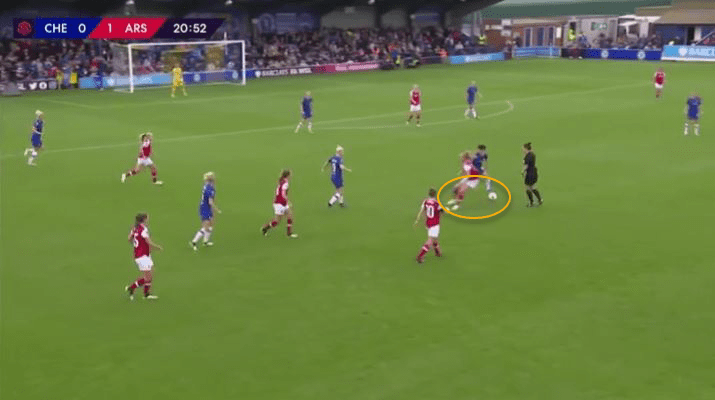
As the above graphic illustrates, Ingle wins the aerial duel with Wälti but it goes straight to Roord. Ji looks to press the Dutch midfielder and wins back possession with Arsenal high up the pitch. The Gunners committed seven players to this attack and Ji’s tackle and break away puts Chelsea on the ascendency.
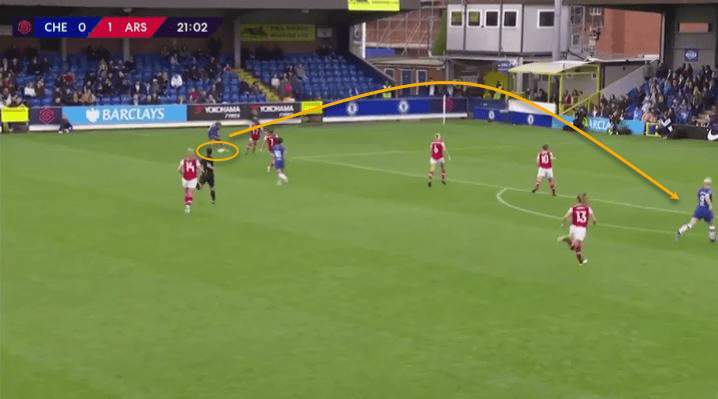
The South Korean number 10 plays a pass towards the onrushing Reiten on the left side who whips in a cross for England in the centre circle that narrowly misses the target. However, notice Arsenal’s disrupted defensive shape and line. The cross causes panic amongst Arsenal’s defence combined with England’s excellent movement in the penalty area to get a header towards goal.
Chelsea’s first goal came courtesy of some brilliant work from Cuthbert to send a through ball for Kirby putting the Blues on a counter-attack with the two strikers combining. While Ji has needed to adapt to a deeper position than her usual number 10 role, Hayes has changed the system to form a partnership between England and Kirby. Throughout the 90 minutes, we could see glimpses of their connection and both players came close to opening the scoring in the first half.
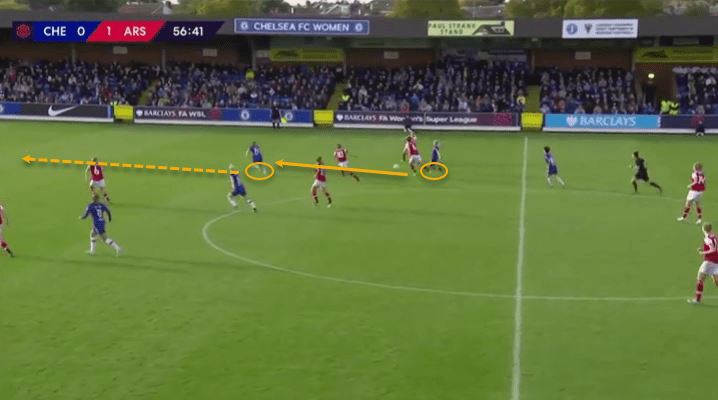
The goal was a combination of everything that Chelsea did well. A long pass into midfield was contested between Ingle and Walti, and the second ball was won by Cuthbert. The graphic above shows Cuthbert’s willingness to make contact and send the ball forward, putting Kirby through unmarked. Chelsea gain numerical superiority against Arsenal’s two centre-backs.
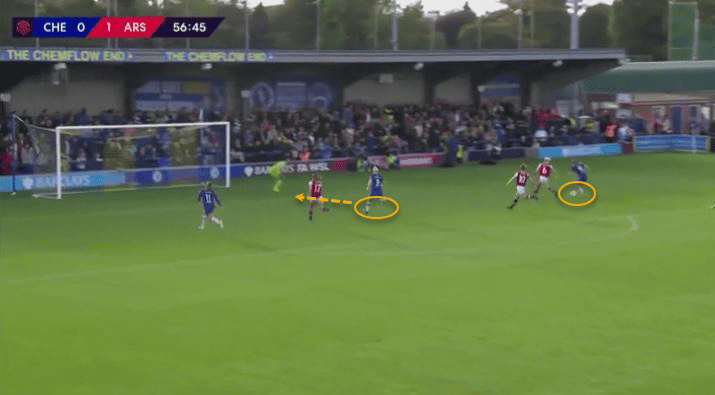
Kirby manages to find space and send in a cross for England who finds space in the box. England manages to collect Kirby’s cross and equalise. Kirby’s attentive run and England’s awareness and first touch were sublime, giving Chelsea a deserved goal.
Maria Thorisdottir and Ramona Bachmann, who both came on in the later stages of the match, proved to be super substitutes when Bachmann teed up her Norwegian team-mate who slammed a rocket of a shot into the top corner.
Conclusion
Through the analysis, we can see how Chelsea Women stamped their authority over the game and showed Arsenal and Manchester City they are contenders for the FAWSL title. Arsenal looked far from the team we’ve seen this season but even the best have an off colour day. Chelsea’s game plan was executed brilliantly and can pose a significant threat in the title race. With three teams now vying for the ultimate prize, it will be interesting to see how the rest of the season pans out.
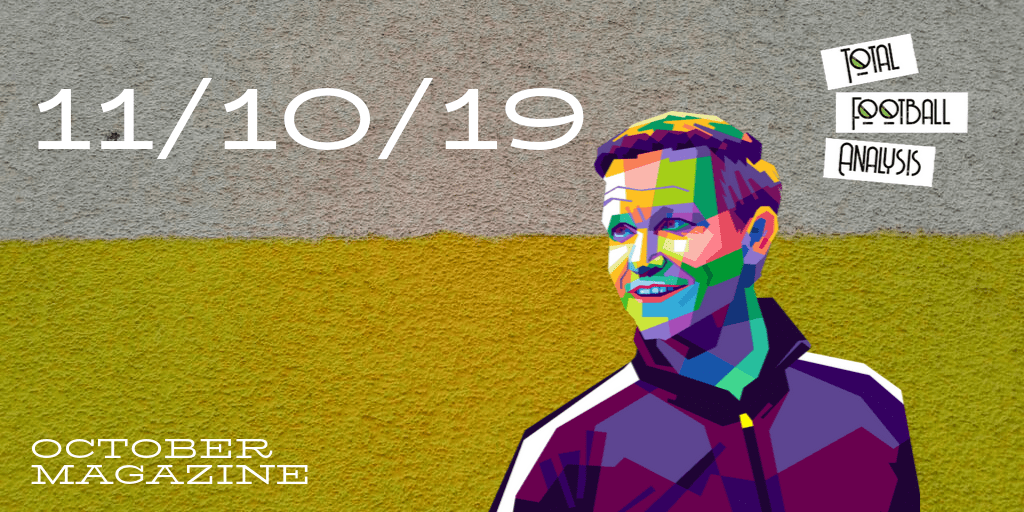
If you love tactical analysis, then you’ll love the digital magazines from totalfootballanalysis.com – a guaranteed 100+ pages of pure tactical analysis covering topics from the Premier League, Serie A, La Liga, Bundesliga and many, many more. Buy your copy of the October issue for just ₤4.99 here






Comments